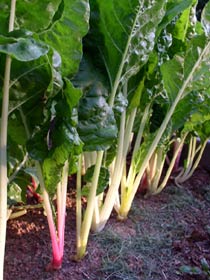Chard

Chard, also called Swiss chard, is a favorite green of many gardeners because it grows well in
both cool and warm weather. This ability to grow through the summer sets it apart from most
greens, and should put chard at the top of your planting list! It's delicious served steamed or stir-
fried, while young, small leaves are tender enough to add to salads. Chard is a good choice for
container growing, especially the decorative varieties with colored stalks.
About This Plant
Chard is actually a bottomless beet. Although a member of the beet family, it doesn't develop
bulbous roots. However, like beets, the large, fleshy stalks and broad, crisp leaves are packed
with minerals. Chard comes in different colors. Varieties such as 'Lucullus' and 'Fordhook Giant'
are green with white stems. 'Rhubarb' and 'Ruby Red' have bright red stems and reddish-green
leaves. And 'Bright Lights' is like a sunset in your garden, with stems ranging from yellow to
intense orange to fuchsia, purple, pink and white, with crinkly green leaves. All varieties of
chard are good from a nutritional standpoint, being high in vitamin A.
Site Selection
Select a site with full sun to light shade and well-drained soil. Prepare the garden bed by using
a garden fork or tiller to loosen the soil to a depth of 12 to 15 inches, then mix in a 2- to 4-inch
layer of compost.
Planting Instructions
Sow chard seeds directly in the garden 2-3 weeks before the expected last spring frost date. If
you really enjoy chard, make two plantings: one in early spring and another one in mid- or late
summer. Gardeners in the Deep South and hot summer areas of the West and Southwest can
plant in late summer and fall for fall and winter harvest, while gardeners in cool summer areas
can make successive sowings throughout the summer.
Sow seeds ?- ? inch deep in rows about 15 inches wide, scattering the seeds an inch or so apart.
Thin the plants to four to five inches apart, then to 10 inches, using the second thinning as young
greens.
Care
Make sure soil moisture stays consistent and give plants a side-dressing of fish emulsion or
a complete organic fertilizer every 4-6 weeks. Contact your local county Cooperative Extension office for
controls of common chard pests, such as leaf miners and flea beetles.
Harvesting
Chard is ready for picking when the leaves are about 6 inches tall. Harvest the outer leaves,
using a sharp knife to cut the stems off at the base. Floating row covers will help prolong fall
harvest by giving the plants some frost protection.






 Chard, also called Swiss chard, is a favorite green of many gardeners because it grows well in
both cool and warm weather. This ability to grow through the summer sets it apart from most
greens, and should put chard at the top of your planting list! It's delicious served steamed or stir-
fried, while young, small leaves are tender enough to add to salads. Chard is a good choice for
container growing, especially the decorative varieties with colored stalks.
Chard, also called Swiss chard, is a favorite green of many gardeners because it grows well in
both cool and warm weather. This ability to grow through the summer sets it apart from most
greens, and should put chard at the top of your planting list! It's delicious served steamed or stir-
fried, while young, small leaves are tender enough to add to salads. Chard is a good choice for
container growing, especially the decorative varieties with colored stalks.